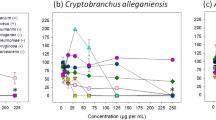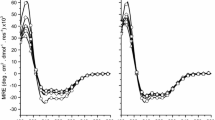Abstract
The improper usage of antibiotics is known to cause widespread antibiotic resistance. In this study, the antibacterial effects of a polypeptide-enriched extract from the skin of the amphibian Rana chensinensis (RCP) were evaluated against the Gram-negative bacteria Escherichia coli and Pseudomonas aeruginosa, the Gram-positive bacterium Staphylococcus aureus and the fungus Candida albicans. The mechanisms underlying these effects were also studied, and the minimum inhibitory concentration of RCP was determined for each species. Analyses of the levels of adenosine triphosphates (ATPases), including Na+/K+-ATPase and Ca2+-ATPase, and scanning electron microscopy confirmed that RCP damaged the microbial cell walls and membranes. RCP perturbed microbial metabolism and particularly affected the tricarboxylic acid cycle (TCA), suggesting that this agent downregulated the levels of succinate dehydrogenase, malate dehydrogenase and ATPase activity in cells. Furthermore, RCP caused the leakage of genetic material from all four microbial strains. In conclusion, RCP effectively inhibited the growth of Gram-negative and Gram-positive bacteria and a fungal species by disrupting energy metabolic processes.





Similar content being viewed by others
References
Ning HQ et al (2019) The synergistic antibacterial properties of glycinin basic peptide against bacteria via membrane damage and inactivation of enzymes. Food Biophys 14(2):132–141
Hu W et al (2019) Antibacterial activity and mechanism of Litsea cubeba essential oil against methicillin-resistant Staphylococcus aureus (MRSA). Ind Crops Prod 130:34–41
Abdelhamid AG, Esaam A, Hazaa MM (2018) Cell free preparations of probiotics exerted antibacterial and antibiofilm activities against multidrug resistant E. coli. Saudi Pharm J 26(5):603–607
Nadhe SB et al (2019) Acinetobacter sp. mediated synthesis of AgNPs, its optimization, characterization and synergistic antifungal activity against C. albicans. J Appl Microbiol 127(2):445–458
Ranjbar M et al (2019) Anti-PcrV IgY antibodies protect against Pseudomonas aeruginosa infection in both acute pneumonia and burn wound models. Mol Immunol 116:98–105
Chelossi E, Faimali M (2006) Comparative assessment of antimicrobial efficacy of new potential biocides for treatment of cooling and ballast waters. Sci Total Environ 356(1–3):1–10
Ymele-Leki P et al (2012) A high-throughput screen identifies a new natural product with broad-spectrum antibacterial activity. PLoS ONE 7(2):8
Terras FR et al (1993) A new family of basic cysteine-rich plant antifungal proteins from Brassicaceae species. FEBS Lett 316(3):233–240
Clark DP et al (1994) Ranalexin. A novel antimicrobial peptide from bullfrog (Rana catesbeiana) skin, structurally related to the bacterial antibiotic, polymyxin. J Biol Chem 269(14):10849–10855
Cole AM, Weis P, Diamond G (1997) Isolation and characterization of pleurocidin, an antimicrobial peptide in the skin secretions of winter flounder. J Biol Chem 272(18):12008–12013
Xue W et al (2018) Optimization of the extraction of Gastrodia elata protein and its antibacterial. J Chin Inst Food Sci Technol 18(04):176–182
Cai XY et al (2019) Candida albicans vaginitis in a murine model is reduced by polypeptide-enriched Gastrodia elata extracts. Future Microbiol 14(10):839–846
Hancock REW, Rozek A (2002) Role of membranes in the activities of antimicrobial cationic peptides. FEMS Microbiol Lett 206(2):143–149
Wang C et al (2017) Cell surface binding, uptaking and anticancer activity of L-K6, a lysine/leucine-rich peptide, on human breast cancer MCF-7 cells. Sci Rep 7:13
Wang ZY et al (2015) Characterization and antioxidant activity in vitro and in vivo of polysaccharide purified from Rana chensinensis skin. Carbohydr Polym 126:17–22
Zhang Y et al (2018) Acute toxicity, antioxidant, and antifatigue activities of protein-rich extract from Oviductus ranae. Oxid Med Cell Longev. https://doi.org/10.1155/2018/9021371
Zhang X et al (2017) Polypeptides from the skin of Rana chensinensis exert the antioxidant and antiapoptotic activities on HaCaT cells. Anim Biotechnol 28(1):1–10
Rinaldi AC (2002) Antimicrobial peptides from amphibian skin: an expanding scenario—commentary. Curr Opin Chem Biol 6(6):799–804
Shen M et al (2017) Antimicrobial activity and membrane interaction mechanism of the antimicrobial peptides derived from Rana chensinensis with short sequences. Biologia 72(9):1089–1097
Jiang YS, Fan WQ, Xu JM (2017) De novo transcriptome analysis and antimicrobial peptides screening in skin of Paa boulengeri. Genes Genomics 39(6):653–665
Lan-Zhou L et al (2015) Study on preparation and in vitro antibacteral activity of polypeptide from the epidermis of Rana chensinensis. J Food Saf Qual 6(03):1067–1072
Gao YT et al (2017) Targeted modification of a novel amphibian antimicrobial peptide from Phyllomedusa tarsius to enhance its activity against MRSA and microbial biofilm. Front Microbiol 8:9
Kifer D, Muzinic V, Klaric MS (2016) Antimicrobial potency of single and combined mupirocin and monoterpenes, thymol, menthol and 1,8-cineole against Staphylococcus aureus planktonic and biofilm growth. J Antibiot 69(9):689–696
Silva JPB et al (2017) Antifungal activity of hydroalcoholic extract of Chrysobalanus icaco against oral clinical isolates of Candida species. Pharmacogn Res 9(1):96–100
Sun XH et al (2018) Antibacterial effect and mechanism of anthocyanin rich Chinese wild blueberry extract on various foodborne pathogens. Food Control 94:155–161
Mandelstam J (1960) The intracellular turnover of protein and nucleic acids and its role in biochemical differentiation. Bacteriol Rev 24(3):289–308
Shen SX et al (2015) Effects of cinnamaldehyde on Escherichia coli and Staphylococcus aureus membrane. Food Control 47:196–202
Lin YL et al (2019) Antibacterial properties and possible action mechanism of chelating peptides-zinc nanocomposite against Escherichia coli. Food Control 106:8
Zhang F et al (2019) Effects of C-terminal amidation and heptapeptide ring on the biological activities and advanced structure of amurin-9KY, a novel antimicrobial peptide identified from the brown frog Rana kunyuensis. Zool Res 40(3):198–204
Shi C, Zhang XW, Guo N (2018) The antimicrobial activities and action-mechanism of tea tree oil against food-borne bacteria in fresh cucumber juice. Microb Pathog 125:262–271
Eom SH et al (2014) The mechanism of antibacterial activity of phlorofucofuroeckol-A against methicillin-resistant Staphylococcus aureus. Appl Microbiol Biotechnol 98(23):9795–9804
Ren XY et al (2019) The antibacterial mechanism of pterostilbene derived from Xinjiang wine grape: a novel apoptosis inducer in Staphyloccocus aureus and Escherichia coli. Lwt-Food Sci Technol 101:100–106
Dannenberg GD et al (2019) Essential oil from pink pepper (Schinus terebinthifolius Raddi): chemical composition, antibacterial activity and mechanism of action. Food Control 95:115–120
Li YH et al (2017) Tea tree oil exhibits antifungal activity against Botrytis cinerea by affecting mitochondria. Food Chem 234:62–67
Fu Y et al (2014) Effects of sub-chronic aluminum chloride exposure on rat ovaries. Life Sci 100(1):61–66
Ontiveros M et al (2019) Natural flavonoids inhibit the plasma membrane Ca2+-ATPase. Biochem Pharmacol 166:1–11
Bhatt DK, Bano M (2009) Modulation of tricarboxylic acid cycle dehydrogenases during hepatocarcinogenesis induced by hexachlorocyclohexane in mice. Exp Toxicol Pathol 61(4):325–332
Funding
This work was funded by the Special Projects of the Cooperation between Jilin University and Jilin Province (Grant No. SXGJXX2017-1), and Industrial Technology Research and Development Projects from Development and Reform Commission of Jilin Province (Grant No. 2019C050-8).
Author information
Authors and Affiliations
Corresponding authors
Ethics declarations
Conflict of interest
The authors have declared that there is no conflict of interest.
Additional information
Publisher's Note
Springer Nature remains neutral with regard to jurisdictional claims in published maps and institutional affiliations.
Rights and permissions
About this article
Cite this article
Wang, R., Zhai, S., Liang, Y. et al. Antibacterial effects of a polypeptide-enriched extract of Rana chensinensis via the regulation of energy metabolism. Mol Biol Rep 47, 4477–4483 (2020). https://doi.org/10.1007/s11033-020-05508-1
Received:
Accepted:
Published:
Issue Date:
DOI: https://doi.org/10.1007/s11033-020-05508-1




